Pratyay Banerjee
Towards LogiGLUE: A Brief Survey and A Benchmark for Analyzing Logical Reasoning Capabilities of Language Models
Oct 02, 2023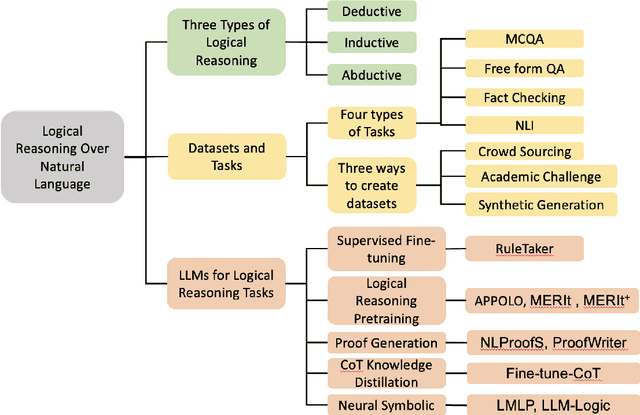
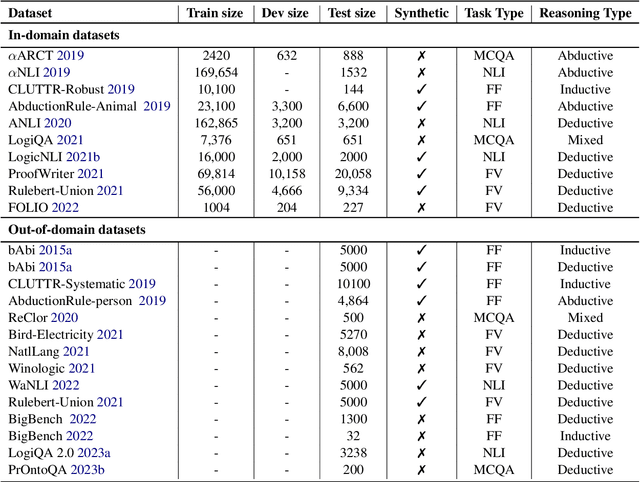
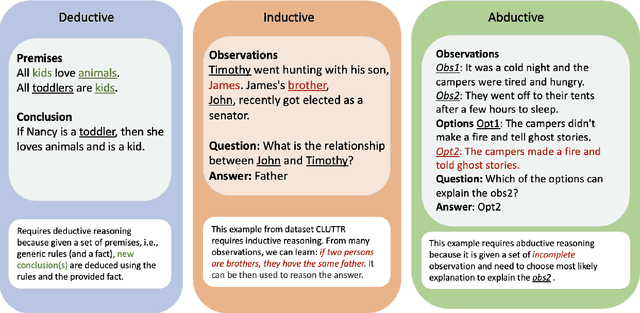
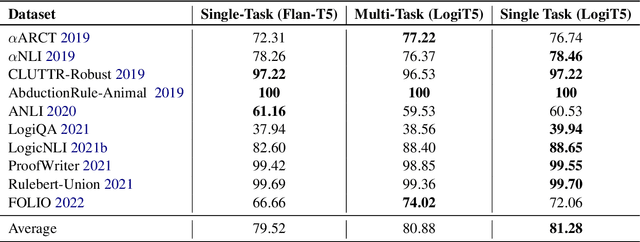
Abstract:Logical reasoning is fundamental for humans yet presents a substantial challenge in the domain of Artificial Intelligence. Initially, researchers used Knowledge Representation and Reasoning (KR) systems that did not scale and required non trivial manual effort. Recently, the emergence of large language models (LLMs) has demonstrated the ability to overcome various limitations of formal Knowledge Representation (KR) systems. Consequently, there is a growing interest in using LLMs for logical reasoning via natural language. This work strives to understand the proficiency of LLMs in logical reasoning by offering a brief review of the latest progress in this area; with a focus on the logical reasoning datasets, tasks, and the methods adopted to utilize LLMs for reasoning. To offer a thorough analysis, we have compiled a benchmark titled LogiGLUE. This includes 24 varied datasets encompassing deductive, abductive, and inductive reasoning. We have standardized these datasets into Seq2Seq tasks to facilitate straightforward training and evaluation for future research. Utilizing LogiGLUE as a foundation, we have trained an instruction fine tuned language model, resulting in LogiT5. We study single task training, multi task training, and a chain of thought knowledge distillation fine tuning technique to assess the performance of model across the different logical reasoning categories. By this comprehensive process, we aim to shed light on the capabilities and potential pathways for enhancing logical reasoning proficiency in LLMs, paving the way for more advanced and nuanced developments in this critical field.
Lexi: Self-Supervised Learning of the UI Language
Jan 23, 2023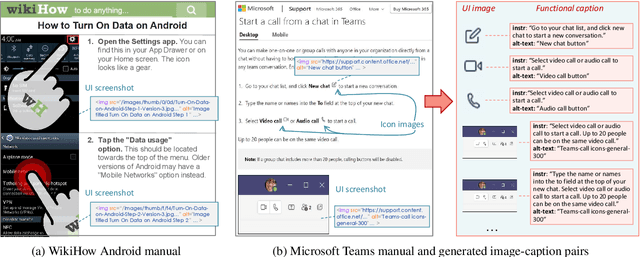

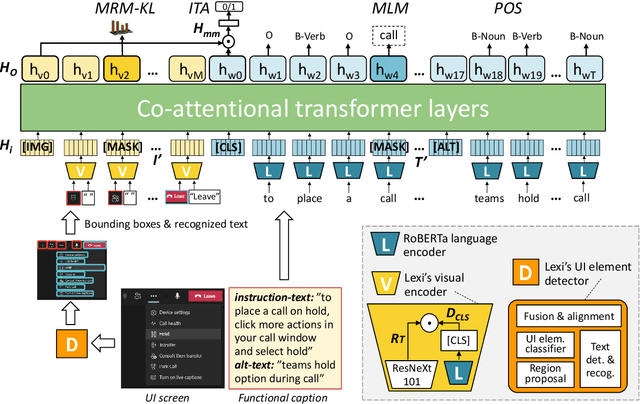

Abstract:Humans can learn to operate the user interface (UI) of an application by reading an instruction manual or how-to guide. Along with text, these resources include visual content such as UI screenshots and images of application icons referenced in the text. We explore how to leverage this data to learn generic visio-linguistic representations of UI screens and their components. These representations are useful in many real applications, such as accessibility, voice navigation, and task automation. Prior UI representation models rely on UI metadata (UI trees and accessibility labels), which is often missing, incompletely defined, or not accessible. We avoid such a dependency, and propose Lexi, a pre-trained vision and language model designed to handle the unique features of UI screens, including their text richness and context sensitivity. To train Lexi we curate the UICaption dataset consisting of 114k UI images paired with descriptions of their functionality. We evaluate Lexi on four tasks: UI action entailment, instruction-based UI image retrieval, grounding referring expressions, and UI entity recognition.
Learning Action-Effect Dynamics from Pairs of Scene-graphs
Dec 07, 2022



Abstract:'Actions' play a vital role in how humans interact with the world. Thus, autonomous agents that would assist us in everyday tasks also require the capability to perform 'Reasoning about Actions & Change' (RAC). Recently, there has been growing interest in the study of RAC with visual and linguistic inputs. Graphs are often used to represent semantic structure of the visual content (i.e. objects, their attributes and relationships among objects), commonly referred to as scene-graphs. In this work, we propose a novel method that leverages scene-graph representation of images to reason about the effects of actions described in natural language. We experiment with existing CLEVR_HYP (Sampat et. al, 2021) dataset and show that our proposed approach is effective in terms of performance, data efficiency, and generalization capability compared to existing models.
Learning Action-Effect Dynamics for Hypothetical Vision-Language Reasoning Task
Dec 07, 2022Abstract:'Actions' play a vital role in how humans interact with the world. Thus, autonomous agents that would assist us in everyday tasks also require the capability to perform 'Reasoning about Actions & Change' (RAC). This has been an important research direction in Artificial Intelligence (AI) in general, but the study of RAC with visual and linguistic inputs is relatively recent. The CLEVR_HYP (Sampat et. al., 2021) is one such testbed for hypothetical vision-language reasoning with actions as the key focus. In this work, we propose a novel learning strategy that can improve reasoning about the effects of actions. We implement an encoder-decoder architecture to learn the representation of actions as vectors. We combine the aforementioned encoder-decoder architecture with existing modality parsers and a scene graph question answering model to evaluate our proposed system on the CLEVR_HYP dataset. We conduct thorough experiments to demonstrate the effectiveness of our proposed approach and discuss its advantages over previous baselines in terms of performance, data efficiency, and generalization capability.
To Find Waldo You Need Contextual Cues: Debiasing Who's Waldo
Mar 30, 2022



Abstract:We present a debiased dataset for the Person-centric Visual Grounding (PCVG) task first proposed by Cui et al. (2021) in the Who's Waldo dataset. Given an image and a caption, PCVG requires pairing up a person's name mentioned in a caption with a bounding box that points to the person in the image. We find that the original Who's Waldo dataset compiled for this task contains a large number of biased samples that are solvable simply by heuristic methods; for instance, in many cases the first name in the sentence corresponds to the largest bounding box, or the sequence of names in the sentence corresponds to an exact left-to-right order in the image. Naturally, models trained on these biased data lead to over-estimation of performance on the benchmark. To enforce models being correct for the correct reasons, we design automated tools to filter and debias the original dataset by ruling out all examples of insufficient context, such as those with no verb or with a long chain of conjunct names in their captions. Our experiments show that our new sub-sampled dataset contains less bias with much lowered heuristic performances and widened gaps between heuristic and supervised methods. We also demonstrate the same benchmark model trained on our debiased training set outperforms that trained on the original biased (and larger) training set on our debiased test set. We argue our debiased dataset offers the PCVG task a more practical baseline for reliable benchmarking and future improvements.
Unsupervised Natural Language Inference Using PHL Triplet Generation
Oct 16, 2021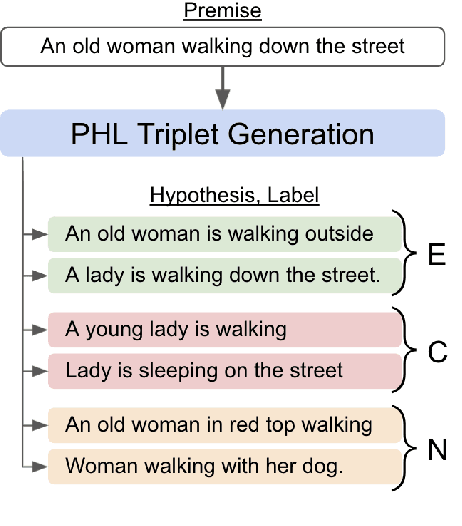

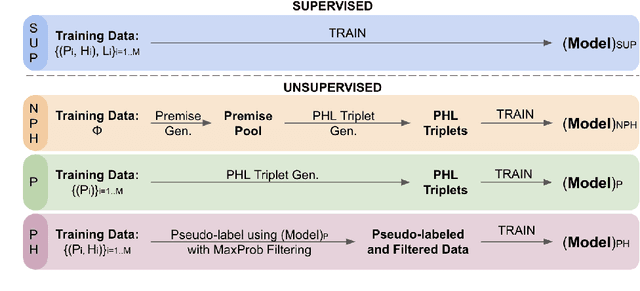
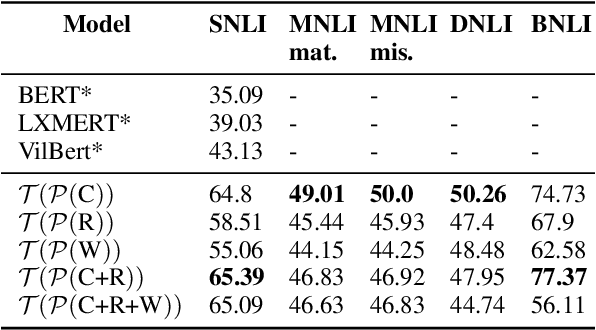
Abstract:Transformer-based models have achieved impressive performance on various Natural Language Inference (NLI) benchmarks, when trained on respective training datasets. However, in certain cases, training samples may not be available or collecting them could be time-consuming and resource-intensive. In this work, we address this challenge and present an explorative study on unsupervised NLI, a paradigm in which no human-annotated training samples are available. We investigate NLI under three challenging settings: PH, P, and NPH that differ in the extent of unlabeled data available for learning. As a solution, we propose a procedural data generation approach that leverages a set of sentence transformations to collect PHL (Premise, Hypothesis, Label) triplets for training NLI models, bypassing the need for human-annotated training datasets. Comprehensive experiments show that this approach results in accuracies of 66.75%, 65.9%, 65.39% in PH, P, NPH settings respectively, outperforming all existing baselines. Furthermore, fine-tuning our models with as little as ~0.1% of the training dataset (500 samples) leads to 12.2% higher accuracy than the model trained from scratch on the same 500 instances.
Semantically Distributed Robust Optimization for Vision-and-Language Inference
Oct 14, 2021



Abstract:Analysis of vision-and-language models has revealed their brittleness under linguistic phenomena such as paraphrasing, negation, textual entailment, and word substitutions with synonyms or antonyms. While data augmentation techniques have been designed to mitigate against these failure modes, methods that can integrate this knowledge into the training pipeline remain under-explored. In this paper, we present \textbf{SDRO}, a model-agnostic method that utilizes a set linguistic transformations in a distributed robust optimization setting, along with an ensembling technique to leverage these transformations during inference. Experiments on benchmark datasets with images (NLVR$^2$) and video (VIOLIN) demonstrate performance improvements as well as robustness to adversarial attacks. Experiments on binary VQA explore the generalizability of this method to other V\&L tasks.
Weakly-Supervised Visual-Retriever-Reader for Knowledge-based Question Answering
Sep 09, 2021



Abstract:Knowledge-based visual question answering (VQA) requires answering questions with external knowledge in addition to the content of images. One dataset that is mostly used in evaluating knowledge-based VQA is OK-VQA, but it lacks a gold standard knowledge corpus for retrieval. Existing work leverage different knowledge bases (e.g., ConceptNet and Wikipedia) to obtain external knowledge. Because of varying knowledge bases, it is hard to fairly compare models' performance. To address this issue, we collect a natural language knowledge base that can be used for any VQA system. Moreover, we propose a Visual Retriever-Reader pipeline to approach knowledge-based VQA. The visual retriever aims to retrieve relevant knowledge, and the visual reader seeks to predict answers based on given knowledge. We introduce various ways to retrieve knowledge using text and images and two reader styles: classification and extraction. Both the retriever and reader are trained with weak supervision. Our experimental results show that a good retriever can significantly improve the reader's performance on the OK-VQA challenge. The code and corpus are provided in https://github.com/luomancs/retriever\_reader\_for\_okvqa.git
Weakly Supervised Relative Spatial Reasoning for Visual Question Answering
Sep 04, 2021



Abstract:Vision-and-language (V\&L) reasoning necessitates perception of visual concepts such as objects and actions, understanding semantics and language grounding, and reasoning about the interplay between the two modalities. One crucial aspect of visual reasoning is spatial understanding, which involves understanding relative locations of objects, i.e.\ implicitly learning the geometry of the scene. In this work, we evaluate the faithfulness of V\&L models to such geometric understanding, by formulating the prediction of pair-wise relative locations of objects as a classification as well as a regression task. Our findings suggest that state-of-the-art transformer-based V\&L models lack sufficient abilities to excel at this task. Motivated by this, we design two objectives as proxies for 3D spatial reasoning (SR) -- object centroid estimation, and relative position estimation, and train V\&L with weak supervision from off-the-shelf depth estimators. This leads to considerable improvements in accuracy for the "GQA" visual question answering challenge (in fully supervised, few-shot, and O.O.D settings) as well as improvements in relative spatial reasoning. Code and data will be released \href{https://github.com/pratyay-banerjee/weak_sup_vqa}{here}.
Constructing Flow Graphs from Procedural Cybersecurity Texts
May 29, 2021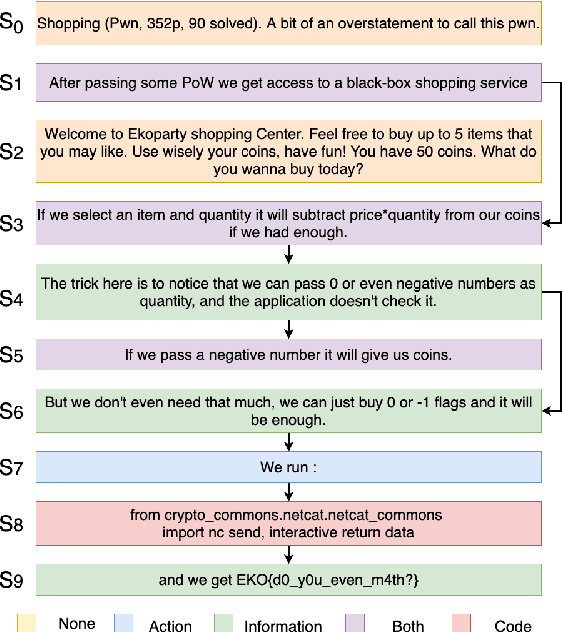
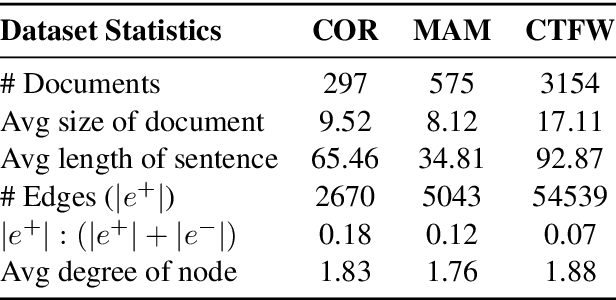
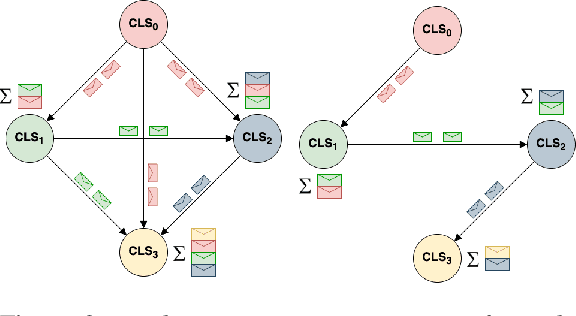

Abstract:Following procedural texts written in natural languages is challenging. We must read the whole text to identify the relevant information or identify the instruction flows to complete a task, which is prone to failures. If such texts are structured, we can readily visualize instruction-flows, reason or infer a particular step, or even build automated systems to help novice agents achieve a goal. However, this structure recovery task is a challenge because of such texts' diverse nature. This paper proposes to identify relevant information from such texts and generate information flows between sentences. We built a large annotated procedural text dataset (CTFW) in the cybersecurity domain (3154 documents). This dataset contains valuable instructions regarding software vulnerability analysis experiences. We performed extensive experiments on CTFW with our LM-GNN model variants in multiple settings. To show the generalizability of both this task and our method, we also experimented with procedural texts from two other domains (Maintenance Manual and Cooking), which are substantially different from cybersecurity. Our experiments show that Graph Convolution Network with BERT sentence embeddings outperforms BERT in all three domains
 Add to Chrome
Add to Chrome Add to Firefox
Add to Firefox Add to Edge
Add to Edge